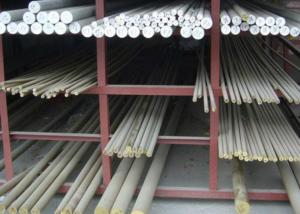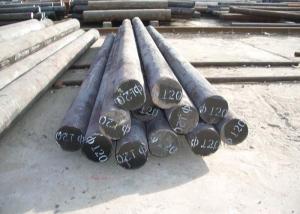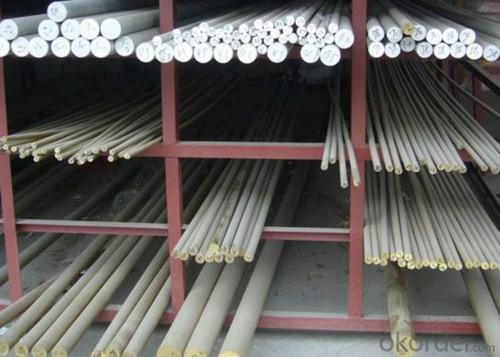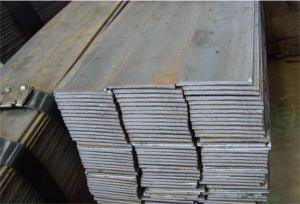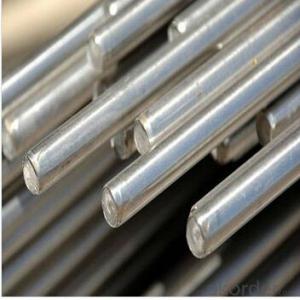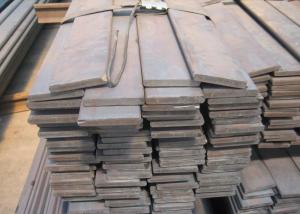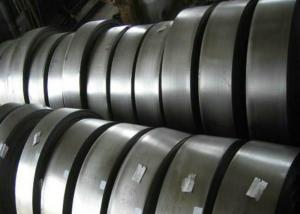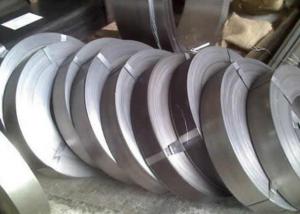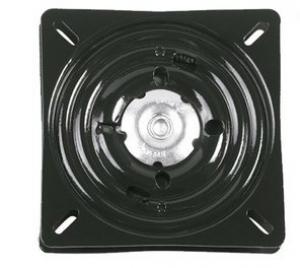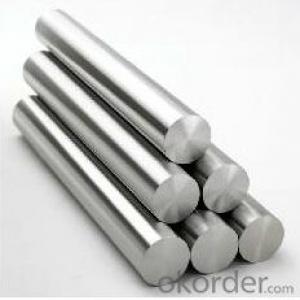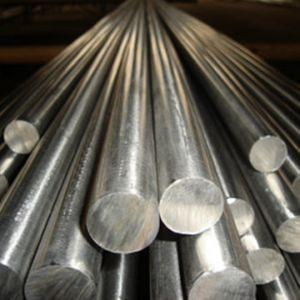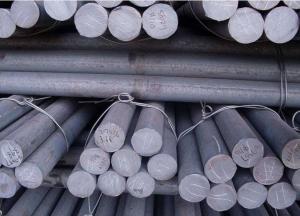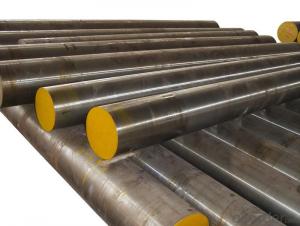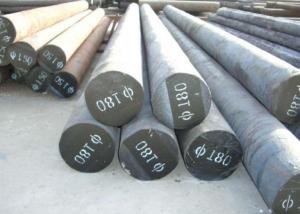Spring Steel Bar
- Loading Port:
- China Main Port
- Payment Terms:
- TT or LC
- Min Order Qty:
- 50Tons m.t.
- Supply Capability:
- 50000TONS /YEAR m.t./month
OKorder Service Pledge
OKorder Financial Service
You Might Also Like
Spring Steel can be divided into two types. One is carbon spring steel, and other one is alloy spring steel.
Alloy spring steel is based on carbon spring steel, by adding one or more alloying elements to improve the mechanical properties, hardenability and other properties to meet the requirement for manufacture all kinds of spring steel.
Specification of Spring Steel Bar:
-Material: SUP6
-Standard: JIS
-Production: Hot rolled or cold rolled
-Type: Spring Steel
-Alloy or no: Alloy
-Micro Structure: Tempered troostite
Corresponding Steel Grade for Reference:
JPN, JIS | CHN, GB | GER, DIN | GBR, BS |
SUP6 | 55Si2Mn | 55Si7 | 251ll60 |
FRA, NF | USA, AISI/SAE | ISO | |
56SC7 | 9260 | 56SiCr7 |
Chemical Composition:
C | Mn | Si | S |
0.56~0.64 | 0.60~0.90 | 1.50~2.00 | ≤0.035 |
P | Cr | Ni | Cu |
≤0.035 | ≤0.35 | ≤0.35 | ≤0.25 |
Mechanical Properties:
-Tensile Strength σb (MPa): ≥1274 (130)
-Yield Strength σs (MPa): ≥1176 (120)
-Elongation δ10(%): ≥5
-Percentage reduction of area: ψ (%): ≥25
-Hardness:
1, Hot rolled, ≤321HB
2, Cold drawn + Heat treatment: ≤321HB
Usage/Applications of Spring Steel Bar:
-This is silicon-manganese spring steel that is used widely. Its strength, elasticity and hardenability are little higher than 55Si2Mn.
- Products of this material are used as flat spring o spiral spring with diameter less than 30mm that bear a large load during the fabrication of trains, cars and tractors.
-The principal material of valve spring.
Packaging & Delivery of Spring Steel Bar:
-Packing Detail: The products can be packed in bundles by steel wires.
-Marks: We will make color marks to make sure that it’s more convenient for customers to distinguish their products from other products at the destination port and we will tie tag marks up to each bundle to make sure that customers know the specifications of each bundle like product’s name and size and other information of products.
-Delivery Detail:
1, Delivery time: 30~45 working days after receive buyer’s T.T. or L/C.
2, Delivery status should be written in the contract. (Heat treatment or no)
Transportation:
1, The products can be delivered by bulk vessel or by container. As for container, products with the length of 6m will be loaded in 20’ container, with 9m or 12m, in 40’ container.
2, The maximum quantity of loading of container is 25 tons.
3, The products are usually transported to the nearest port from the production place.
Photos of Spring Steel Bar:
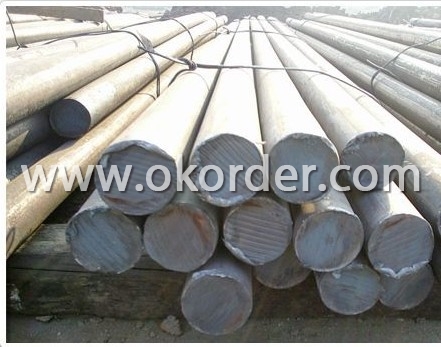

- Q: What are the main characteristics of heat-resistant steel forgings?
- High-temperature applications can benefit from the use of heat-resistant steel forgings due to their distinct characteristics. Firstly, these forgings possess exceptional resistance to oxidation and corrosion, enabling them to maintain their mechanical properties even under elevated temperatures. This resistance is achieved by incorporating alloying elements such as chromium, nickel, and molybdenum, which form a protective oxide layer on the steel's surface. Secondly, heat-resistant steel forgings demonstrate remarkable strength and toughness when exposed to high temperatures. This is crucial for applications that subject the material to mechanical stress and thermal cycling, such as gas turbines, power plants, and aerospace engines. The combination of high strength and toughness ensures that the forgings can endure harsh operating conditions without deformation or failure. Another significant characteristic of heat-resistant steel forgings is their ability to retain hardness and dimensional stability even after prolonged exposure to high temperatures. This is accomplished through meticulous alloying and heat treatment processes, optimizing the steel's microstructure. As a result, the material possesses a fine grain structure and high uniformity, enhancing its resistance to thermal fatigue and creep. Moreover, heat-resistant steel forgings exhibit good thermal conductivity, facilitating efficient heat transfer and dissipation. This is particularly important in applications where heat generation needs effective management to prevent overheating and damage to surrounding components. Lastly, heat-resistant steel forgings can be easily machined and fabricated into intricate shapes, making them versatile and suitable for various applications. They can be forged, machined, and welded without significant loss of mechanical properties, making them ideal for manufacturing components with complex designs and high precision requirements. In conclusion, the main characteristics of heat-resistant steel forgings include excellent resistance to oxidation and corrosion, high strength and toughness at high temperatures, dimensional stability and hardness retention, good thermal conductivity, and ease of machining and fabrication. These characteristics make heat-resistant steel forgings indispensable in industries that require reliable and durable materials in extreme heat conditions.
- Q: What are the different classifications of special steel?
- Special steel is a broad term that encompasses various types of steel alloys that possess unique properties and characteristics, making them suitable for specific applications. There are several classifications of special steel, including: 1. Stainless Steel: This type of special steel contains a high percentage of chromium, which provides excellent corrosion resistance. It also typically contains other elements like nickel and molybdenum, enhancing its strength and durability. Stainless steel is commonly used in applications that require resistance to oxidation, heat, chemicals, and wear, such as in food processing, medical devices, and construction. 2. Tool Steel: Tool steel is specifically designed for manufacturing tools, dies, and molds. It is known for its exceptional hardness, wear resistance, and toughness. Tool steel is further classified into several subcategories, including high-speed steel (HSS), cold work steel, hot work steel, and plastic mold steel, each tailored for specific tooling applications. 3. Alloy Steel: Alloy steel is a type of special steel that contains additional alloying elements apart from carbon. These elements, such as manganese, silicon, nickel, chromium, and molybdenum, are added to enhance specific properties like strength, toughness, hardenability, and corrosion resistance. Alloy steels are used in various applications, such as automotive components, machinery, construction, and aerospace. 4. Spring Steel: This type of special steel is specifically designed to withstand repeated bending or twisting without permanently deforming. Spring steel has excellent elasticity and fatigue resistance, making it suitable for applications such as springs, suspension systems, and high-performance automotive parts. 5. Bearing Steel: Bearing steel is engineered to provide high hardness, wear resistance, and dimensional stability necessary for manufacturing bearings. It typically contains high levels of carbon, chromium, and other alloying elements, ensuring the required mechanical properties for reliable and long-lasting bearings. 6. Electrical Steel: Electrical steel, also known as silicon steel, is specifically designed for electrical applications. It possesses low electrical resistivity and high magnetic permeability, allowing it to efficiently conduct and transform electrical energy. Electrical steel is commonly used in transformers, electric motors, and generators. These classifications of special steel highlight the versatility and tailored properties of different steel alloys, enabling their application in a wide range of industries and specialized uses.
- Q: What are the challenges in forging special steel?
- Forging special steel poses several challenges due to its unique composition and properties. Firstly, special steels often have high carbon content, making them harder to forge compared to lower carbon steels. The high carbon content increases the risk of cracking and requires careful temperature control during the forging process to prevent metallurgical issues. Secondly, special steels may contain alloying elements like chromium, molybdenum, or nickel, which enhance their specific properties. However, these alloying elements can also contribute to increased hardness and brittleness, making the forging process more challenging. Special attention must be given to heat treatment procedures to achieve the desired balance of strength and toughness. Furthermore, the complex internal structure of special steels, including the presence of inclusions and segregation, can further complicate the forging process. These internal defects can lead to uneven deformation, inadequate mechanical properties, or even failure during forging, necessitating meticulous quality control measures. Lastly, the cost of special steel materials is generally higher than that of regular steels, making any errors or wasted materials during the forging process more significant. The need for specialized equipment, skilled labor, and stringent quality assurance further adds to the challenges associated with forging special steel. Overall, forging special steel demands expertise, precision, and meticulous control of various parameters to ensure the desired mechanical properties and quality of the final product.
- Q: Can special steel be used in electrical applications?
- Special steel can indeed find its use in electrical applications. There exist specific properties in special steel alloys, like stainless steel or tool steel, that render them appropriate for usage in electrical applications. These properties encompass excellent electrical conductivity, remarkable resistance against corrosion, and commendable strength. To illustrate, stainless steel frequently finds its application in electrical enclosures, wire mesh, and connectors, owing to its ability to ward off corrosion caused by moisture or chemicals. Conversely, tool steel is commonly employed in the production of electrical tools and equipment, such as pliers or screwdrivers, due to its superior strength and durability. On the whole, special steel alloys can provide the desired electrical properties and performance required for diverse electrical applications.
- Q: How does special steel withstand high-velocity impacts?
- Due to its unique properties and composition, special steel possesses the capability to endure high-velocity impacts. A crucial factor contributing to this capability is its high strength and hardness, which allows it to withstand extreme forces without deforming or fracturing. Additionally, special steel often incorporates alloying elements like chromium, molybdenum, nickel, and vanadium, which enhance its exceptional toughness and resistance to impacts. Furthermore, special steel frequently undergoes heat treatment to improve its mechanical properties. This involves processes like quenching and tempering that modify the steel's microstructure, resulting in a refined and strengthened structure. This heat treatment also augments the steel's capacity to absorb and disperse energy during high-velocity impacts, thereby lowering the risk of failure. Moreover, special steel is frequently tailored with specific alloys and compositions to optimize its performance in specific applications. For instance, certain grades of steel are engineered specifically for armor applications, where they must endure high-velocity impacts from projectiles. These steels may incorporate additional elements like boron or titanium, further enhancing their ability to resist penetration and deformation under extreme loads. In conclusion, special steel's ability to withstand high-velocity impacts can be attributed to its high strength, hardness, toughness, and impact resistance. Its distinctive composition, heat treatment processes, and targeted design render it a dependable choice for applications where impact resistance is of utmost importance.
- Q: Can special steel be used in the cement manufacturing industry?
- Yes, special steel can be used in the cement manufacturing industry. Special steel is often used for various applications in the cement industry, such as in the construction of kilns, crushers, mills, and other heavy-duty equipment. Its high strength, corrosion resistance, and durability make it suitable for withstanding the harsh conditions and abrasive materials involved in cement production.
- Q: How does special steel perform in high-temperature strength?
- Special steel performs well in high-temperature strength due to its unique composition and properties. It is specifically designed to withstand and maintain its mechanical strength and structural integrity at elevated temperatures. This is achieved through the careful selection of alloying elements, heat treatment processes, and precise control of microstructure. Special steel exhibits excellent resistance to deformation, creep, and oxidation, making it a preferred choice for applications that involve high temperatures, such as in power generation, aerospace, and industrial processing.
- Q: How is free-cutting steel used in the production of precision components?
- Free-cutting steel is used in the production of precision components due to its enhanced machinability. This type of steel contains additives such as sulfur, lead, or bismuth, which help in breaking the chips during machining, resulting in improved cutting performance. This makes it easier for manufacturers to achieve high precision and accuracy when shaping and forming the steel into intricate components. Additionally, free-cutting steel reduces tool wear and increases production efficiency, making it a preferred choice in industries requiring precise and complex parts, such as automotive, aerospace, and medical.
- Q: What are the different non-destructive testing techniques used for special steel?
- There are several non-destructive testing (NDT) techniques that are commonly used for special steel to ensure its quality and integrity without causing any damage. These techniques are essential in industries where special steel is used, such as aerospace, automotive, and construction, to ensure that the material meets the required specifications and standards. Some of the commonly used NDT techniques for special steel are: 1. Ultrasonic Testing (UT): This technique involves the use of high-frequency sound waves to detect internal flaws, such as cracks, voids, or inclusions, in special steel. UT is highly effective in detecting subsurface defects and is widely used due to its versatility and accuracy. 2. Magnetic Particle Testing (MT): MT is a technique that uses magnetic fields and iron particles to detect surface or near-surface defects in special steel. It is particularly useful in identifying defects like cracks, seams, or laps, as the magnetic particles will accumulate at these locations, making them visible under proper lighting conditions. 3. Liquid Penetrant Testing (PT): PT is a widely-used method for detecting surface defects in special steel. It involves applying a liquid penetrant to the surface of the material, which seeps into any surface cracks or defects. After a specified time, the excess penetrant is removed, and a developer is applied to make the defects visible. 4. Eddy Current Testing (ET): ET utilizes electromagnetic induction to detect surface or near-surface defects in special steel. It is particularly useful in detecting cracks, corrosion, or metal loss in conductive materials. ET is a fast and accurate method, making it suitable for high-speed production environments. 5. Radiographic Testing (RT): RT involves the use of X-rays or gamma rays to examine the internal structure of special steel. It can detect various defects, including porosity, inclusions, and cracks. RT provides detailed images that help identify the location, size, and severity of defects. 6. Visual Testing (VT): VT is a simple yet crucial technique that involves a visual examination of the surface of special steel. It helps identify surface defects like scratches, dents, or corrosion. Although VT is not as sensitive as other NDT techniques, it is often used as a preliminary inspection method. Each of these non-destructive testing techniques has its own advantages and limitations. The selection of the appropriate technique depends on factors such as the type and size of the special steel, the required inspection depth, and the specific defects that need to be detected. By using a combination of these techniques, manufacturers and inspectors can ensure the quality and reliability of special steel products.
- Q: What are the different surface hardening grades of special steel?
- There are several surface hardening grades of special steel, including case-hardening steels such as 1018, 8620, and 8620H, which are commonly used for applications requiring a hard outer layer and a tough core. Another grade is nitriding steel, such as 4140, 4340, and 410, which are specifically designed for nitriding processes to improve wear resistance. Additionally, tool steels like D2, A2, and O1 are often used for surface hardening applications due to their high hardness and wear resistance properties. Overall, the choice of surface hardening grade depends on the specific requirements of the application.
1. Manufacturer Overview
| Location | Jiangsu, China |
| Year Established | 2003 |
| Annual Output Value | Above US$ 30 Million |
| Main Markets | Asia-Pacific; Middle east |
| Company Certifications |
2. Manufacturer Certificates
| a) Certification Name | |
| Range | |
| Reference | |
| Validity Period |
3. Manufacturer Capability
| a) Trade Capacity | |
| Nearest Port | Shanghai. |
| Export Percentage | 20% - 30% |
| No.of Employees in Trade Department | 10-20 People |
| Language Spoken: | English; Chinese |
| b) Factory Information | |
| Factory Size: | Above 100,000 square meters |
| No. of Production Lines | 2 |
| Contract Manufacturing | OEM Service Offered; |
| Product Price Range | Average |
Send your message to us
Spring Steel Bar
- Loading Port:
- China Main Port
- Payment Terms:
- TT or LC
- Min Order Qty:
- 50Tons m.t.
- Supply Capability:
- 50000TONS /YEAR m.t./month
OKorder Service Pledge
OKorder Financial Service
Similar products
Hot products
Hot Searches
Related keywords
